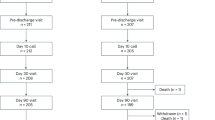Abstract
In some hypertensive patients, echocardiographic examination does not reveal any pathologic finding in spite of a documented blood pressure elevation. In our study, we investigated the effect of preload reduction with Valsalva manoeuver on transmitral flow velocities in hypertensive patients with normal mitral flow pattern and compared the results with a healthy control group. Sixty-eight patients without evidence of coronary artery disease or heart failure (28 female, 40 male, age 50 ± 7) were divided in two groups according to their E/A ratio as those with diastolic dysfunction (n = 36) and without diastolic dysfunction (DD−: n = 32). DD− patients and the control group (n = 20) performed Valsalva manoeuver and their pulsed-Doppler mitral flow measurements were repeated at the strain phase. During Valsalva manoeuver, E wave velocity decreased in all subjects. In the controls, peak A velocity showed a similar decline and E/A ratio remained over 1.0. However, in 72% of DD− patients A velocity did not change or increased and their E/A ratio fell below 1.0. In 47% of the patients with an E/A ratio reversal after Valsalva manoeuver, myocardial perfusion scintigraphy revealed reversible defects whereas none of the patients whose E/A ratio remained over 1.0 had perfusion defects. It is concluded that: (1) in hypertensive patients with normal E/A ratio Valsalva manoeuver should be performed in order to unmask a probable false normal finding, (2) an important percent of hypertensive individuals have left ventricular relaxation abnormalities, and (3) diastolic dysfunction develops together with a decrease in coronary reserve.
This is a preview of subscription content, access via your institution
Access options
Subscribe to this journal
Receive 12 digital issues and online access to articles
$119.00 per year
only $9.92 per issue
Buy this article
- Purchase on Springer Link
- Instant access to full article PDF
Prices may be subject to local taxes which are calculated during checkout
Similar content being viewed by others
References
1999 World Health Organization-International Society of Hypertension Guidelines for the Management of Hypertension Guidelines Subcommittee J Hypertens 1999 17 151–183
Joint National Committee on Detection, Evaluation and Treatment of High Blood Pressure The sixth report of the Joint National Committee on Detection, Evaluation and Treatment of High Blood Pressure (JNC-VI) Arch Int Med 1997 157 2413–2446
Strauer BE, Schwartzkopff B Objectives of high blood pressure treatment: left ventricular hypertrophy, diastolic function, and coronary reserve Am J Hypertens 1998 11 879–881
Inouye I et alAbnormal left ventricular filling: an early finding in mild to moderate hypertension Am J Cardiol 1984 53 120–126
Kapuku GK et alImpaired left ventricular filling in borderline hypertensivepatients without cardiac structural changes Am Heart J 1993 125 1710–1716
Berk MR et alReduction of left ventricular preload by lower body negative pressure alters Doppler transmitral filling patterns J Am Coll Cardiol 1990 16 1387–1392
Masuyama T, St Goar FG, Alderman EL, Popp RL. Effects of nitroprusside on transmitral flow velocity patterns in extreme heart failure: a combined hemodynamic and Doppler echocardiographic study of varying loading conditions J Am Coll Cardiol 1990 16 1175–1185
Hurrell DG, Nishimura RA, Ilstrup DM, Appleton CP Utility of preload alteration in assessment of left ventricular filling pressure by Doppler echocardiography: a simultaneous catheterization and Doppler echocardiographic study J Am Coll Cardiol 1997 30 459–467
Nishimura RA, Tajik AJ Evaluation of diastolic filling of left ventricle in health and disease: Doppler echocardiography is the clinician’s Rosetta Stone J Am Coll Cardiol 1997 30 8–18
Rakowski H et alCanadian consensus recommendations for the measurement and reporting of diastolic dysfunction by echocardiography: from the Investigators of Consensus on Diastolic Dysfunction by Echocardiography J Am Soc Echocardiogr 1996 9 736–760
Sahn DJ, DeMaria A, Kisslo J, Weyman A Recommendations regarding quantitation in M-mode echocardiography: results of a survey of echocardiographic measurements Circulation 1978 58 1072–1083
Devereux RB et alEchocardiographic assessment of left ventricular hypertrophy: comparison to necropsy findings Am J Cardiol 1986 57 450–458
Levy D et al Echocardiographic criteria for left ventricular hypertrophy: the Framingham Heart Study Am J Cardiol 1987 59 956–960
Choong YC, Herrmann HC, Weyman AE, Fifer MA Preload dependence of Doppler-derived indexes of left ventricular diastolic function in humans J Am Coll Cardiol 1987 10 800–808
Triulzi MO, Castini D, Ornaghi M, Vitolo E Effects of preload reduction on mitral flow velocity pattern in normal subjects Am J Cardiol 1990 66 995–1001
Meijburg HW et alNormal pulmonary venous flow characteristics as assessed by transesophageal pulsed Doppler echocardiography J Am Soc Echocardiogr 1992 5 588–597
Wijbenga A et alPotentials and limitations of the Valsalva maneuver as a method of differentiating between normal and pseudonormal left ventricular filling patterns Am J Cardiol 1999 84 76–81
Downes TR et alEffect of alteration in loading conditions on both normal and abnormal patterns of left ventricular filling in healthy individuals Am J Cardiol 1990 65 377–382
Dumesnil JG, Gaudreault G, Honos GN, Kingma JG Jr Use of Valsalva maneuver to unmask left ventricular diastolic function abnormalities by Doppler echocardiography inpatients with coronary artery disease or systemic hypertension Am J Cardiol 1991 68 515–519
Shimizu Y et alPeak negative myocardial velocity gradient in early diastole as a noninvasive indicator of left ventricular diastolic function: comparison with transmural flow indices J Am Coll Cardiol 1998 32 1418–1425
Regolisti G et alEffects of reduced preload on diastolic filling in essential hypertensivepatients with increased left ventricular mass Am J Hypertens 1997 10 447–453
Castini D et alEffects of venous reduction in hypertensivepatients: is there a Doppler diastolic dysfunction index independent of preload reduction? Am Heart J 1992 123 1299–1306
Palatini P et alStructural abnormalities and not diastolic dysfunction are the earliest left ventricular changes in hypertension. HARVEST Study Group Am J Hypertens 1998 11 147–154
Author information
Authors and Affiliations
Corresponding author
Rights and permissions
About this article
Cite this article
Ural, D., Ural, E., Kahraman, G. et al. Effect of the Valsalva manoeuver on diastolic filling indices in patients with essential hypertension. J Hum Hypertens 15, 607–612 (2001). https://doi.org/10.1038/sj.jhh.1001232
Received:
Accepted:
Published:
Issue Date:
DOI: https://doi.org/10.1038/sj.jhh.1001232



